Physical Address
304 North Cardinal St.
Dorchester Center, MA 02124
Physical Address
304 North Cardinal St.
Dorchester Center, MA 02124
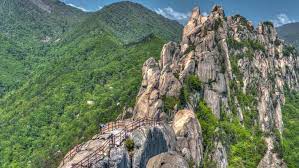
If you’re a nature lover, South Korea is the perfect destination for you. The country boasts an impressive array of national parks that offer breathtaking scenery, diverse wildlife, and memorable hiking experiences. From the towering peaks of Seoraksan National Park to the tranquil forests of Gayasan National Park, there’s something for everyone in South Korea’s national park system.
In this guide, we’ll take a closer look at five of South Korea’s most popular national parks: Seoraksan National Park, Jirisan National Park, Bukhansan National Park, Gayasan National Park, and Hallasan National Park. We’ll explore each park’s unique features and what makes it worth visiting. Whether you’re an avid hiker or just looking for a peaceful escape in nature, this guide will help you plan your next adventure in South Korea’s stunning national parks.
Each national park in South Korea is well-equipped with visitor centers that provide a wealth of resources to enhance your experience. These centers offer detailed maps and brochures that outline the various trails and attractions within the park, making it easier for visitors to plan their adventures. Information on the local flora and fauna is readily available, allowing nature enthusiasts to appreciate the biodiversity more deeply. Knowledgeable staff are on hand to answer questions and offer guided tours, enriching your visit with expert insights. Interactive exhibits and multimedia presentations at some centers provide a deeper understanding of the natural and cultural history, ensuring your adventure is both educational and enjoyable.
In addition to maps and guided tours, the visitor centers also host engaging workshops focused on local traditions and natural crafts. These workshops provide visitors with a hands-on experience, allowing them to learn about traditional Korean practices such as making tea from native herbs or crafting small items from sustainably sourced wood. Visitors can also attend seminars and talks led by experts who share insights into the park’s ecology and the measures taken to maintain its pristine environment. Such activities not only enrich the visitor experience but also foster a deeper connection to the cultural and ecological heritage of South Korea’s treasured landscapes.
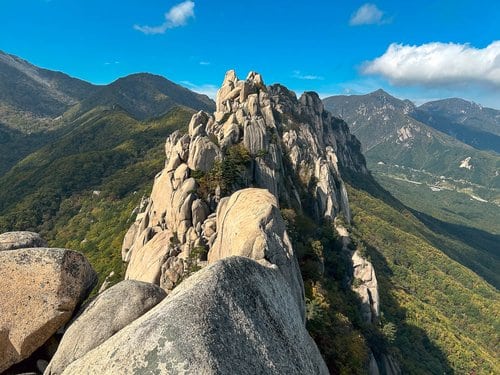
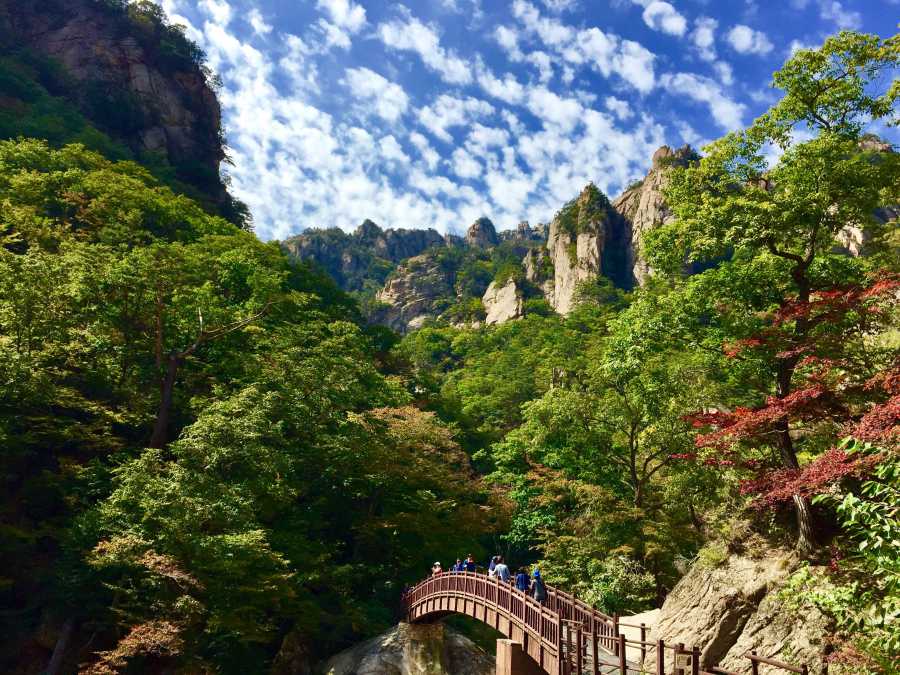
You’ll be awed by the majestic beauty of Seoraksan National Park, where towering peaks and lush forests await your exploration. This park is home to some of South Korea’s most picturesque landscapes, including the highest peak on the Korean peninsula, Daecheongbong. As you hike through its trails, you’ll be surrounded by stunning vistas of granite cliffs, waterfalls, and pristine lakes.
One of Seoraksan’s main attractions is the cable car ride up to Gwongeumseong Fortress. From there, you can take in panoramic views of the surrounding mountains and valleys. For a more challenging adventure, try scaling Ulsanbawi Rock or trekking along one of the park’s many hiking trails. Along these paths, you may spot some rare wildlife such as musk deer or Asiatic black bears.
As you explore Seoraksan National Park, don’t forget to take a moment to appreciate its cultural significance as well. The area has been considered sacred since ancient times and is dotted with Buddhist temples and shrines. In fact, it was designated as a Biosphere Reserve by UNESCO in recognition of its unique blend of natural beauty and cultural heritage. Now that you’ve experienced this stunning national park, let’s move on to Jirisan National Park for more adventures!
Seoraksan National Park offers a variety of activities that change with the seasons, each providing a unique way to experience its beauty. In spring, the park comes alive with cherry blossoms, drawing visitors who wish to stroll beneath a canopy of pink flowers. Summer is perfect for hiking and exploring the lush greenery that covers the landscape. As autumn approaches, the foliage transforms into a stunning display of reds and golds, creating a picturesque setting for photographers and nature lovers as well. Winter blankets the park in snow, offering opportunities for snowshoeing and appreciating the tranquil, frosty vistas. Each season presents a new way to enjoy Seoraksan’s natural wonders.
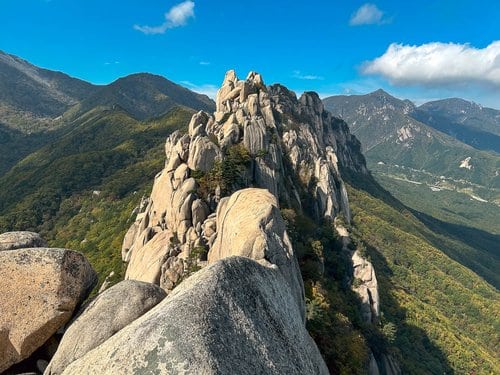
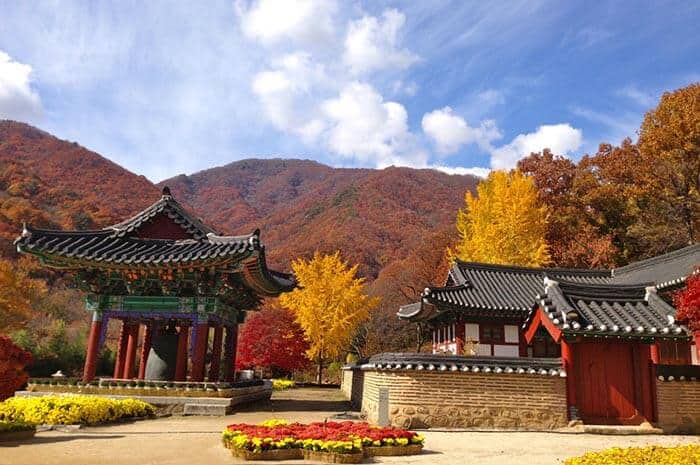
Exploring Jirisan National Park is a must-do for nature enthusiasts visiting South Korea. This park covers three provinces and is considered the largest in mainland South Korea. Jirisan’s natural beauty offers visitors an opportunity to hike through dense forests, climb steep peaks, and witness breathtaking waterfalls.
To fully experience all that Jirisan has to offer, here are some activities you should consider adding to your itinerary:
With its vast size and diverse landscape, Jirisan National Park will surely leave a lasting impression on any visitor. Whether you’re an avid hiker or simply enjoy being surrounded by nature’s beauty, this park has something for everyone. As you venture out of Jirisan and into Bukhansan National Park next door, get ready for even more stunning views and adventures.
Jirisan National Park is a biodiversity hotspot, home to a wide variety of plant and animal species. The park’s expansive forests are inhabited by the elusive Asiatic black bear, a protected species that highlights the park’s conservation efforts. Colorful wildflowers like azaleas and lilies add color to the landscape, especially in late spring and early summer. The park’s valleys and slopes are also home to various bird species, offering birdwatchers chances to spot rare and migratory species. This rich diversity makes Jirisan a paradise for wildlife enthusiasts and conservationists across the globe.
Are you ready for an unforgettable hiking experience? Look no further than Bukhansan National Park, where you can trek to the iconic Baegundae Peak and take in stunning views of Seoul. But it’s not just about the scenery; this national park also boasts historic temples and fortresses that offer a glimpse into Korea’s rich cultural heritage. Lace up your boots, pack some snacks, and get ready for an adventure you won’t forget!
Ready to conquer the challenge of hiking to the breathtaking Baegundae Peak? This iconic peak is one of the most popular trails in Bukhansan National Park, and for good reason. The hike up to the summit may be steep at times, but it rewards you with stunning panoramic views of Seoul and its surroundings.
Before embarking on your adventure, make sure to check the weather forecast and bring appropriate gear such as sturdy hiking shoes, sunscreen, a hat, and plenty of water. The trail itself is well-marked with clear signs along the way. As you hike up towards Baegundae Peak, take a moment to enjoy the surrounding nature. You’ll pass by streams, rock formations and lush greenery that make this national park so special. Once you reach the top, take a break and enjoy a snack while taking in some of Seoul’s best views from above.
| Distance | Difficulty | Time Required |
|---|---|---|
| 3.6 km | Moderate | 2-3 hours |
Don’t forget your camera as this is an experience worth capturing! After conquering Baegundae Peak’s challenge, get ready for another adventure as we explore how to enjoy stunning views of Seoul.
To fully appreciate the stunning views of Seoul, you should head to one of the city’s many observation decks. The Namsan Tower is a popular spot that offers panoramic views of the city skyline and beyond. You can take a cable car or hike up to the top for an unforgettable experience.
Another great option is the Lotte World Tower, which stands at 555 meters tall and boasts a glass-bottomed observation deck on its 118th floor. From here, you can see all the way to Incheon on a clear day. Once you’ve taken in the breathtaking sights from above, it’s time to explore the history and culture of South Korea by visiting its historic temples and fortresses.
Now that you’ve taken in the breathtaking views of Seoul, it’s time to explore the historic temples and fortresses that dot South Korea’s landscape. These ancient structures offer a glimpse into the country’s rich cultural heritage and are well worth a visit during your trip to South Korea.
One of the most famous examples is Gyeongbokgung Palace, located in central Seoul. This palace was built in 1395 and served as the main royal residence for several centuries. The complex includes numerous buildings, halls, and gardens that are open to visitors year-round. Other notable sites include Hwaseong Fortress in Suwon, which dates back to the late 18th century, and Bulguksa Temple in Gyeongju, which is renowned for its intricate carvings and beautiful artwork. To help you plan your temple-hopping adventure, we’ve compiled a table below with some of our top picks:
| Site Name | Location | Year Built | Notable Features |
|---|---|---|---|
| Gyeongbokgung Palace | Seoul | 1395 | Main royal residence; changing of the guard ceremony |
| Hwaseong Fortress | Suwon | Late 18th century | UNESCO World Heritage Site; fortress walls stretch over 5km |
| Bulguksa Temple | Gyeongju | 8th century (rebuilt in 1600s) | UNESCO World Heritage Site; houses many national treasures |
Exploring these historic temples and fortresses will give you a deeper appreciation for South Korea’s rich culture and history. Plus, they make for some incredible photo opportunities! Next up on our tour of South Korea’s national parks is Gayasan National Park…
Bukhansan National Park is not only a haven for hikers but also a site of immense cultural and historical significance. The park is home to several ancient fortresses and temples that reflect South Korea’s historical roots. The Bukhansanseong Fortress, built during the Joseon Dynasty, stands as proof of the ingenuity and resilience of Korean architects. Meanwhile, the park’s temples, like Doseonsa, offer peaceful retreats where visitors can experience traditional Buddhist practices. These cultural sites provide insight into the spiritual and historical heritage that continues to shape Korean identity today.

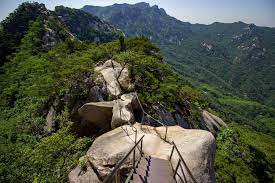
You’ll be amazed by the stunning views of Gayasan National Park’s peaks and valleys. Located in the south-central region of South Korea, this park is home to the famous Haeinsa Temple, a UNESCO World Heritage Site that houses the Tripitaka Koreana, a collection of Buddhist scriptures carved onto wooden blocks. The park also offers numerous hiking trails for visitors to explore its diverse flora and fauna.
One of the most popular hikes in Gayasan National Park is to Mount Gayasan’s summit, which stands at over 1,400 meters tall. The hike can take between four to six hours depending on your pace, but it’s worth it for the breathtaking panoramic views from the top. Along the way, you’ll encounter various temples and shrines nestled among lush forests and rocky terrain.
Gayasan National Park is an ideal destination for nature lovers seeking adventure or tranquility. Whether you’re looking to challenge yourself with a rigorous hike or simply enjoy a peaceful stroll through its serene landscapes, this national park has something for everyone. Next up is Hallasan National Park, where you’ll discover yet another natural wonder waiting to be explored!
Efforts to preserve South Korea’s national parks are ongoing and multifaceted, focusing on the protection of both natural ecosystems and cultural landmarks. Conservation programs aim to maintain biodiversity by safeguarding habitats and monitoring endangered species like the Asiatic black bear. Initiatives to prevent soil erosion and protect water sources are essential for sustaining the natural landscapes. Park authorities also enforce strict regulations on waste management and visitor behavior to minimize human impact. Educational programs and events are regularly held to raise awareness about the importance of conservation, encouraging visitors and locals nearby to participate in preserving these treasured natural locations.
Each park is implementing innovative sustainability initiatives, harnessing renewable energy sources and promoting eco-friendly practices at facilities and accommodations. Solar panels and wind turbines help power remote visitor centers, reducing reliance on non-renewable resources. Initiatives to reduce waste include the promotion of reusable alternatives and strict recycling protocols. Furthermore, local communities often collaborate with park authorities to create eco-tourism programs that benefit the environment and the local economy, ensuring sustainable development and conservation go hand in hand. These efforts underscore a commitment to sustainability, setting a precedent for parks worldwide.
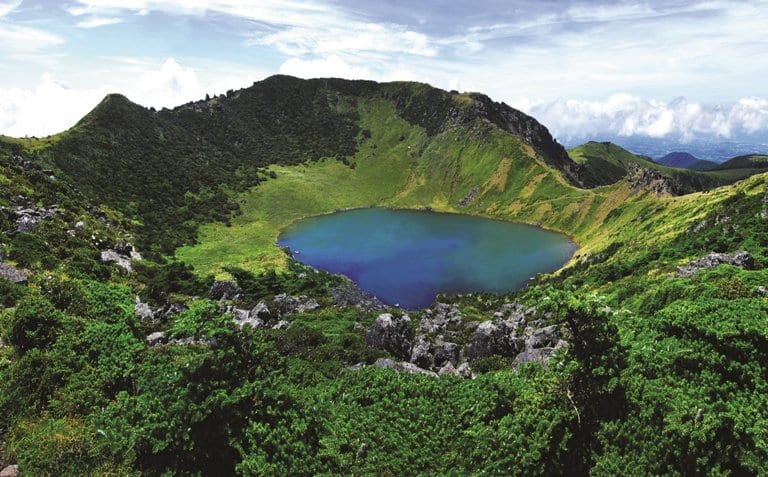
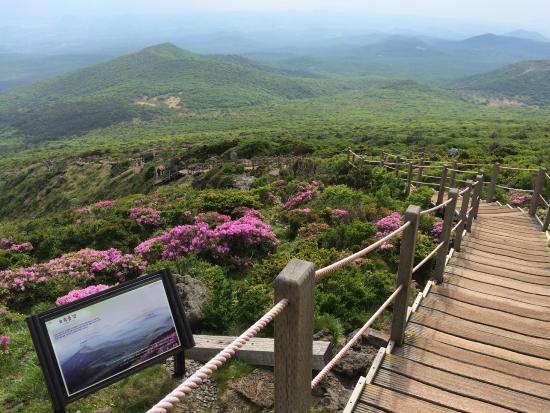
Get ready to explore Hallasan National Park, a breathtaking natural wonder located on Jeju Island! This stunning destination is home to the highest mountain in South Korea, Mount Halla. With its lush forests, crystal-clear streams, and diverse flora and fauna, it’s no wonder that this park attracts visitors from all over the world.
One of the best ways to experience Hallasan National Park is by hiking one of its many trails. There are routes for all skill levels, so whether you’re an experienced hiker or a beginner, you’ll find something that suits you. The Eorimok Trail is a popular choice as it takes you through dense forests and offers panoramic views of the island. For those looking for a more challenging hike, the Gwaneumsa Trail will take you to the summit of Mount Halla where you’ll be rewarded with spectacular views.
Aside from hiking, there are plenty of other activities to enjoy in Hallasan National Park. You can go horse riding, cycling or even try your hand at fishing in one of its scenic lakes. And if you’re lucky enough to visit during springtime, don’t miss out on seeing the cherry blossoms in full bloom – it’s truly a sight to behold! So pack your bags and get ready for an unforgettable adventure in Hallasan National Park!
Once the sun sets over South Korea’s national parks, a whole new world emerges above. Many of these parks, such as Jirisan and Seoraksan, offer some of the best stargazing opportunities in the country, free from the light pollution of urban areas. Visitors can enjoy the splendor of the Milky Way and glimpse constellations that have guided navigators and inspired storytellers for generations. Occasionally, the parks host special stargazing events, complete with telescopes and guided sessions by astronomical experts. Whether you’re an astronomy enthusiast or simply gazing up in wonder, the night skies add a magical dimension to any visit.
Yes, visitors are allowed to bring their own food and drinks into the national parks in South Korea. In fact, it is encouraged for visitors to pack a picnic or snacks as many of the parks have designated areas for picnicking. However, it is important to note that littering is strictly prohibited in all national parks and visitors must dispose of their trash properly. Additionally, some parks may have restrictions on open fires or certain types of food (such as alcohol) so it is recommended to check park regulations before planning your outdoor meal. Overall, bringing your own food and drinks can enhance your national park experience while also ensuring you follow responsible tourism practices.
There are some restrictions on the type of photography equipment that visitors can bring into South Korea’s national parks. For instance, drones are not allowed to be flown within the parks unless specifically authorized by park officials. Additionally, tripods and other large equipment may be prohibited in certain areas where they could pose a safety hazard to visitors or damage sensitive ecosystems. However, most standard photography equipment like cameras and lenses are generally permitted as long as they do not disrupt other visitors or wildlife. So if you’re planning on taking photos during your visit to a national park in South Korea, it’s best to check with park officials before bringing any specialized equipment with you.
The opening and closing times of South Korea’s national parks vary depending on the season and park. Generally, most parks are open from early morning until sunset or 10 pm. However, some parks have different hours for specific areas or facilities within the park. It is best to check with each individual park before you go to ensure you have accurate information. Keep in mind that during peak season, such as spring and fall foliage, many parks may have extended hours. So if you’re planning a trip to one of South Korea’s beautiful national parks, be sure to plan ahead so that you can maximize your time there!
Before entering any of South Korea’s national parks, it’s important to be aware of the safety guidelines in order to have a safe and enjoyable experience. One important rule is to stay on designated trails and paths at all times, as veering off can lead to dangerous situations such as getting lost or encountering wildlife. Additionally, visitors should be mindful of weather conditions and dress accordingly, especially during winter months when temperatures can drop significantly. It’s also recommended to bring plenty of water and snacks, as well as a first aid kit in case of emergencies. Finally, while exploring the parks, always be conscious of your surroundings and follow any posted signs or instructions from park officials for your own safety.
If you’re looking to spend the night in one of South Korea’s national parks, you’re in luck! Many of the parks have nearby accommodations ranging from camping sites to lodges. For example, Seoraksan National Park has several lodges and guesthouses within close proximity, as well as established campgrounds. Jirisan National Park also offers a variety of lodging options such as cabins and traditional Korean-style houses. Be sure to book ahead of time, especially during peak season, and check if there are any restrictions or guidelines for staying overnight in the park.
Whether you’re an avid hiker or simply looking for a peaceful retreat from city life, South Korea’s national parks are sure to impress. So why not pack your bags and head out on an adventure? With so much beauty waiting to be discovered, there’s never been a better time to explore this fascinating country. So what are you waiting for? Get out there and start exploring!